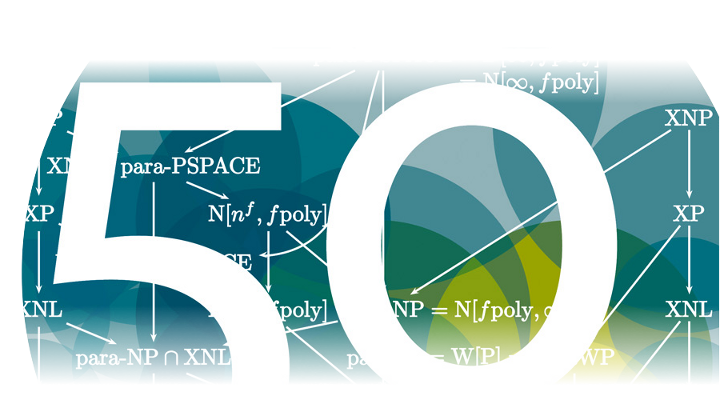-
12. Dezember 2000, 18 Uhr ct H1/SFS
Dr. Berthold Vöcking, MPI für Informatik, Saarbrücken
How Asymmetry Helps Load Balancing
This talk deals with balls and bins processes related to
randomized load balancing, dynamic resource allocation, and hashing.
Suppose n balls have to be assigned to n
bins, where each ball has to be placed without knowledge about the distribution of
previously placed balls. The goal is to achieve an allocation that is
as even as possible so that no bin gets much more balls than the average.
A well known and good solution for this problem is to choose d
possible locations for each ball at random, to look into each of these
bins, and to place the ball into the least full among these bins. This
class of algorithms has been investigated intensively in the past, but
almost all previous analyses assume that the dlocations
for each ball are chosen uniformly and independently at random from the set of
all bins.
We investigate whether a non-uniform and possibly dependent choice of the d
locations for a ball can improve the load balancing. Three types of
selections are distinguished: 1) uniform and independent 2) non-uniform
and independent 3) non-uniform and dependent. Our first result shows
that choosing the locations in a non-uniform way (type 2) results in a
better load balancing than choosing the locations uniformly (type 1).
Surprisingly, this smooth load balancing is obtained by an algorithm
called ``Always-Go-Left'' which creates an asymmetric assignment of the
balls to the bins. Our second result is a lower bound on the smallest
possible maximum load that can be achieved by any allocation algorithm
of type 1, 2, or 3. Our upper and lower bounds are tight up to a small
additive constant, showing that the Always-Go-Left scheme achieves
almost the optimal load balancing.
Furthermore, we show that our upper bound can be generalized to infinite processes in which balls are inserted
and deleted by an adversary.
-
6. September 2000, 11 Uhr ct, H1/SFS
Prof. Faith E. Fich, University of Toronto/Canada
Lower Bounds for Distributed Computing
What can be computed in a distributed system in which faults can occur? This
talk will address what CANNOT be computed in certain environments or
when insufficient resources are available. A number of techniques for
obtaining lower bounds and impossibility results in distributed
computing will be surveyed. These include valency arguments, covering
arguments, characterizations, and topological arguments.
-
21. Juni 2000, 17 Uhr ct, H3, Haus 21
Prof. Dr. Raul Rojas, Freie Universität Berlin
Die Computer des Konrad Zuse: Ein moderner Rückblick auf den Anfang der Computerentwicklungen vor 60 Jahren.<
In meinem Vortrag werde ich die Architektur der ersten von Konrad Zuse
gebauten Rechenmaschinen erläutern. Allen lag ein gemeinsamer
Gedanke zugrunde: die Effiziente Ausführung von
Gleitkomma-Operationen für wissenschaftliches Rechnen.
Speziell gilt für diese Maschinen:
- Sie waren Floating-Point Rechner
- Der Prozessor war vom Speicher getrennt
- Die Addition wurde in konstanter Zeit berechnet (d.h. unabhängig von der Anzahl der Bits)
- Shifts wurden ebenfalls in konstanter Zeit berechnet
- Die Maschinen waren Mikroprogrammiert
Ich werde auch zeigen, dass diese Maschinen universell waren, d.h. eine
Turing Maschine liesse sich damit simulieren, obwohl der bedingte
Sprung nicht im Befehlssatz vorhanden war.
Am Ende werde ich die Verbindung zwischen dem Plankalkül und den
Rechenmaschinen erläutern. Ich werde Simulationen der
Rechenmaschinen, den ersten Plankalkül-Compiler, sowie das erste Schachprogramm
der Welt laufen lassen.
Mehr
Information unter: www.zib.de/zuse
Zum Vortragenden: Prof. Rojas ist Leiter der Arbeitsgruppe
Künstliche Intelligenz an der FU
Berlin .
Neben zahlreichen Zeitschriften-Veröffentlichungen hat er als
Autor oder Herausgeber mehrere Bü verfasst, u.a. "The First
Computers - History and Architectures", "Die Rechenmaschinen von Konrad
Zuse", "Neural Networks - A Systematic Introduction" und "Die Armut der
Nationen".
Die Arbeitsgruppe ist Europameister 2000 in Robotic Soccer (small size category)
-
8. Juni 2000, 18 Uhr ct, Hörsaal 1/SFS
Prof. Carl Smith, Department of Computer Science, University of Maryland
Towards a Model of Object Oriented Programming
We introduce an object-oriented model of computation called OOPSILON. We
prove that it is Church-Rosser, Turing-complete, and an acceptable
programming system. The first two properties make this a valid model of
computation worth studying, while the third supplies a unique notion of
self
given for free by the Recursion Theorem.
OOPSILON differs from previous object calculi through its direct support for
partially-constructed objects, and for data-driven rather than
function-driven programming. It also serves as a nice formalism to
discuss context.
(Joint work with Ken Regan and Brian Postow)
-
30. Mai 2000, 16 Uhr ct, Raum H1/SFS
Hagen Völzer, Institut für Informatik, Humboldt-Universität zu Berlin
Fairness, Randomisierung und Konspiration in verteilten Algorithmen
Zur Lösung grundlegender Synchronisations- und
Koordinationsprobleme in verteilten Systemen (z.B. Mutex-Problem, Konsens-Problem) verwendet
man Konzepte wie Fairness, Randomisierung und Synchronie, Manchmal kann
man nachweisen, dass ohne solche Konzepte keine Lösung
für bestimmte Probleme existiert. Solche Unmöglichkeitsresultate
verbessern unser Verständnis der Wirkungsweise verteilter
Algorithmen.
In dieser Arbeit werden zwei neue Unmöglichkeitsresultate gezeigt
und die Ursachen untersucht. Dabei spielt ein grundlegendes
Phänomen in verteilten Systemen eine entscheidende Rolle,
für das in der Literatur der Begriff Konspiration geprägt wurde.
Konspiration verhindert, dass ein Algorithmus seine Ziele erreicht und
ist daher unerwünscht. In dieser Arbeit gelang es Konspiration
zu charakterisieren und einen Zusammenhang von Konspiration und
Fehlertoleranz darzustellen.




